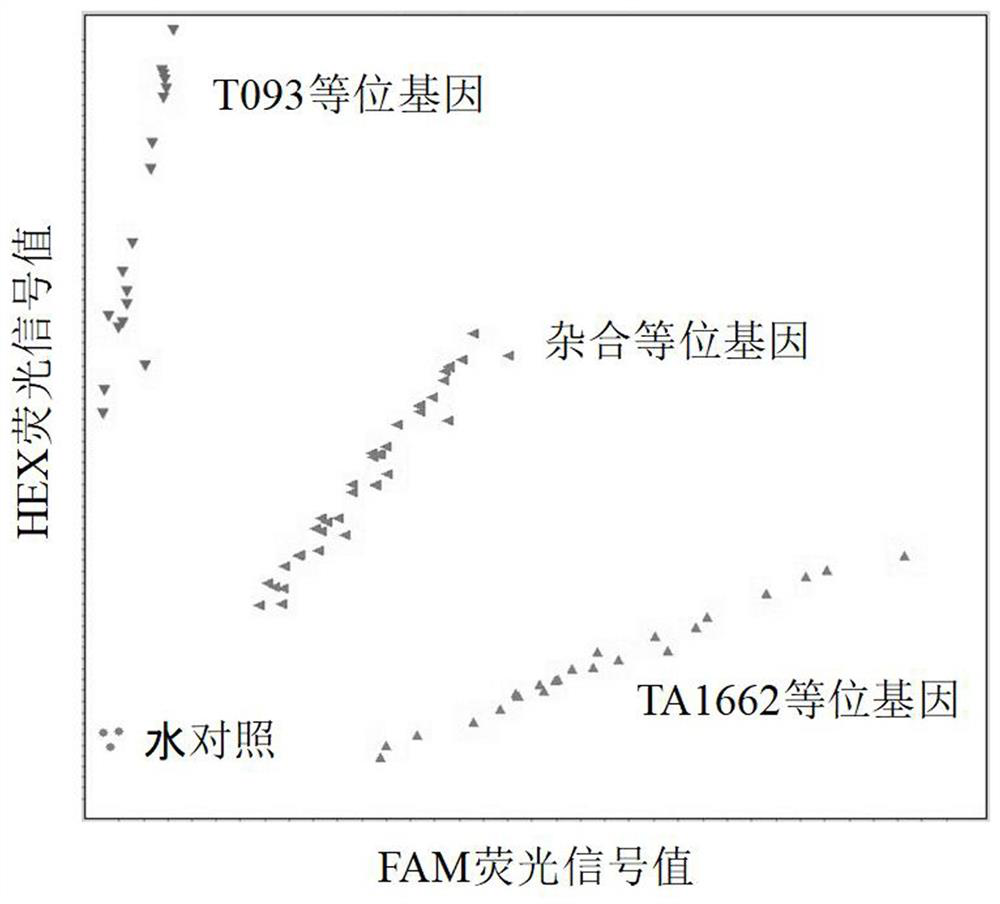KASP molecular marker co-segregated with powdery mildew resistant gene Pm58 and application of KASP molecular marker
A powdery mildew resistance gene and molecular marker technology, applied in the field of crop breeding, can solve the problems such as the difficulty of using excellent disease-resistant alleles, and achieve the effects of solving linkage burden, stable amplification, and convenient detection
- Summary
- Abstract
- Description
- Claims
- Application Information
AI Technical Summary
Problems solved by technology
Method used
Image
Examples
Embodiment 1
[0045] Example 1 Powdery Mildew Resistance Gene of Knott wheat Pm58 Acquisition of co-segregated molecular markers
[0046] (1) (T093×TA1662) F 2 group building and Pm58 Screening for segmental recombinants
[0047] (1) The powdery mildew-susceptible parent T093 (♀) was crossed with the powdery mildew-resistant parent TA1662 (♂) to obtain the hybrid F 1 , F 1 Selfing produced F containing 676 individuals 2 group;
[0048] (2) Extract F by CTAB method 2 The DNA of each individual plant in the population; using Pm58 border markers Xhnu670 and Xhnu186 from F 2 Thirteen individual plants recombined in this segment were screened out in the population.
[0049] (2) 13 F's 2 Identification of Powdery Mildew Resistance in Selfed Progenies of Generational Recombinants
[0050] Powdery mildew resistance identification was carried out in the plant growth box, from each F 2 Randomly select 25 seeds from the self-bred progeny of the generation recombinant, and plant them in...
Embodiment 2
[0060] Example 2 Powdery Mildew Resistance Gene of Knott wheat Pm58 Application of co-segregated molecular markers
[0061] The resistance to powdery mildew was identified on a germplasm population containing 178 accessions of Triticum japonicus and 158 accessions of common wheat. The identification was carried out in a plant growth chamber, and the identification method was the same as in Example 1. Genomic DNA was extracted from all materials by the CTAB method, and Xkasp68500 Perform PCR amplification. The amplification method of KASP marker is the same as that in Example 1. Use LightCycler 480 software v1.5.1.62 software to analyze the fluorescence signal value of the amplified product, and record the results.
[0062] The results showed that only 5 of the 178 wheat germplasm materials carried the powdery mildew resistance allele consistent with TA1662, and these 5 materials were all resistant to powdery mildew strain E09. However, among the 158 accessions of common ...
PUM
 Login to View More
Login to View More Abstract
Description
Claims
Application Information
 Login to View More
Login to View More - R&D
- Intellectual Property
- Life Sciences
- Materials
- Tech Scout
- Unparalleled Data Quality
- Higher Quality Content
- 60% Fewer Hallucinations
Browse by: Latest US Patents, China's latest patents, Technical Efficacy Thesaurus, Application Domain, Technology Topic, Popular Technical Reports.
© 2025 PatSnap. All rights reserved.Legal|Privacy policy|Modern Slavery Act Transparency Statement|Sitemap|About US| Contact US: help@patsnap.com



